Literature Review: Psychological Impact of Stoma Patients
VerifiedAdded on 2022/08/21
|11
|3333
|15
Report
AI Summary
This report presents a comprehensive literature review examining the psychological impact of stoma on patients. The review synthesizes findings from various studies, including those focusing on inclusion and exclusion criteria, search strategies, and the quality assessment of qualitative studies. The report analyzes the aims, methodologies, and main findings of selected articles, highlighting factors such as self-care education, body image, self-esteem, and anxiety in stoma patients. Key findings include the impact of stoma on quality of life, the influence of body image on adaptation, and the importance of addressing psychological well-being. The review also identifies limitations in existing research and suggests areas for future investigation, such as the need for more extensive patient evaluations and the development of targeted interventions to improve patient outcomes.
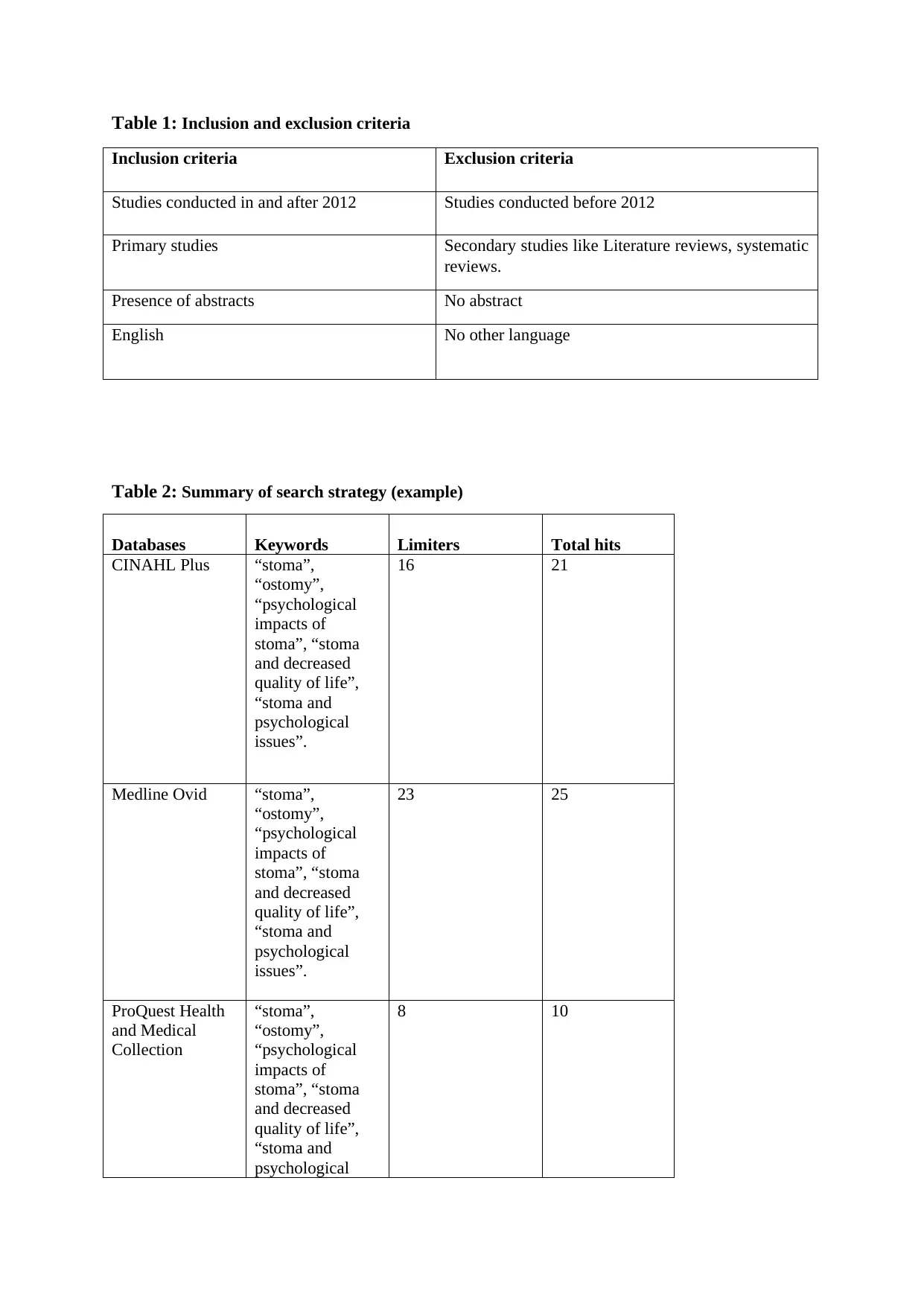
Table 1: Inclusion and exclusion criteria
Inclusion criteria Exclusion criteria
Studies conducted in and after 2012 Studies conducted before 2012
Primary studies Secondary studies like Literature reviews, systematic
reviews.
Presence of abstracts No abstract
English No other language
Table 2: Summary of search strategy (example)
Databases Keywords Limiters Total hits
CINAHL Plus “stoma”,
“ostomy”,
“psychological
impacts of
stoma”, “stoma
and decreased
quality of life”,
“stoma and
psychological
issues”.
16 21
Medline Ovid “stoma”,
“ostomy”,
“psychological
impacts of
stoma”, “stoma
and decreased
quality of life”,
“stoma and
psychological
issues”.
23 25
ProQuest Health
and Medical
Collection
“stoma”,
“ostomy”,
“psychological
impacts of
stoma”, “stoma
and decreased
quality of life”,
“stoma and
psychological
8 10
Inclusion criteria Exclusion criteria
Studies conducted in and after 2012 Studies conducted before 2012
Primary studies Secondary studies like Literature reviews, systematic
reviews.
Presence of abstracts No abstract
English No other language
Table 2: Summary of search strategy (example)
Databases Keywords Limiters Total hits
CINAHL Plus “stoma”,
“ostomy”,
“psychological
impacts of
stoma”, “stoma
and decreased
quality of life”,
“stoma and
psychological
issues”.
16 21
Medline Ovid “stoma”,
“ostomy”,
“psychological
impacts of
stoma”, “stoma
and decreased
quality of life”,
“stoma and
psychological
issues”.
23 25
ProQuest Health
and Medical
Collection
“stoma”,
“ostomy”,
“psychological
impacts of
stoma”, “stoma
and decreased
quality of life”,
“stoma and
psychological
8 10
Paraphrase This Document
Need a fresh take? Get an instant paraphrase of this document with our AI Paraphraser
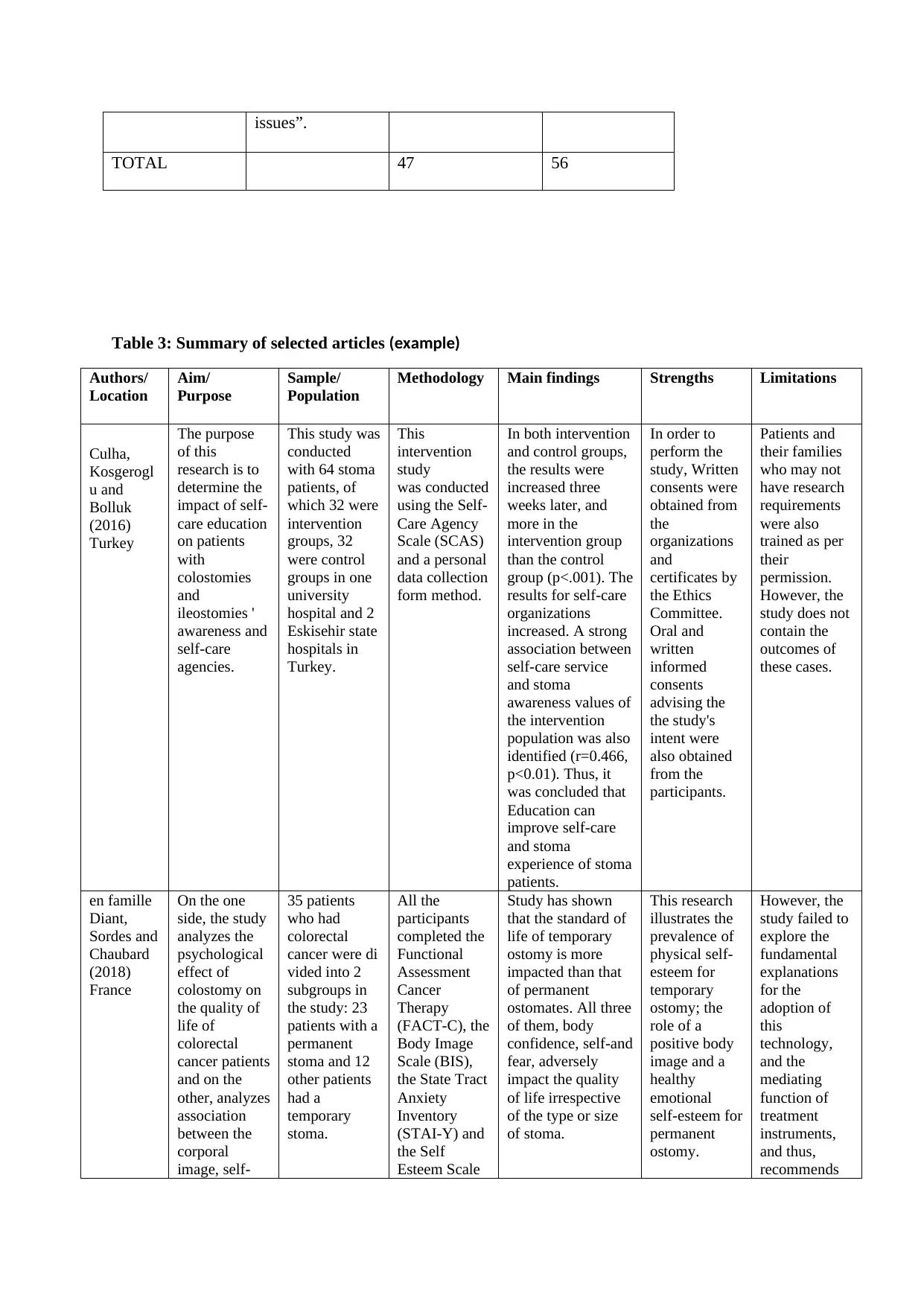
issues”.
TOTAL 47 56
Table 3: Summary of selected articles (example)
Authors/
Location
Aim/
Purpose
Sample/
Population
Methodology Main findings Strengths Limitations
Culha,
Kosgerogl
u and
Bolluk
(2016)
Turkey
The purpose
of this
research is to
determine the
impact of self-
care education
on patients
with
colostomies
and
ileostomies '
awareness and
self-care
agencies.
This study was
conducted
with 64 stoma
patients, of
which 32 were
intervention
groups, 32
were control
groups in one
university
hospital and 2
Eskisehir state
hospitals in
Turkey.
This
intervention
study
was conducted
using the Self-
Care Agency
Scale (SCAS)
and a personal
data collection
form method.
In both intervention
and control groups,
the results were
increased three
weeks later, and
more in the
intervention group
than the control
group (p<.001). The
results for self-care
organizations
increased. A strong
association between
self-care service
and stoma
awareness values of
the intervention
population was also
identified (r=0.466,
p<0.01). Thus, it
was concluded that
Education can
improve self-care
and stoma
experience of stoma
patients.
In order to
perform the
study, Written
consents were
obtained from
the
organizations
and
certificates by
the Ethics
Committee.
Oral and
written
informed
consents
advising the
the study's
intent were
also obtained
from the
participants.
Patients and
their families
who may not
have research
requirements
were also
trained as per
their
permission.
However, the
study does not
contain the
outcomes of
these cases.
en famille
Diant,
Sordes and
Chaubard
(2018)
France
On the one
side, the study
analyzes the
psychological
effect of
colostomy on
the quality of
life of
colorectal
cancer patients
and on the
other, analyzes
association
between the
corporal
image, self-
35 patients
who had
colorectal
cancer were di
vided into 2
subgroups in
the study: 23
patients with a
permanent
stoma and 12
other patients
had a
temporary
stoma.
All the
participants
completed the
Functional
Assessment
Cancer
Therapy
(FACT-C), the
Body Image
Scale (BIS),
the State Tract
Anxiety
Inventory
(STAI-Y) and
the Self
Esteem Scale
Study has shown
that the standard of
life of temporary
ostomy is more
impacted than that
of permanent
ostomates. All three
of them, body
confidence, self-and
fear, adversely
impact the quality
of life irrespective
of the type or size
of stoma.
This research
illustrates the
prevalence of
physical self-
esteem for
temporary
ostomy; the
role of a
positive body
image and a
healthy
emotional
self-esteem for
permanent
ostomy.
However, the
study failed to
explore the
fundamental
explanations
for the
adoption of
this
technology,
and the
mediating
function of
treatment
instruments,
and thus,
recommends
TOTAL 47 56
Table 3: Summary of selected articles (example)
Authors/
Location
Aim/
Purpose
Sample/
Population
Methodology Main findings Strengths Limitations
Culha,
Kosgerogl
u and
Bolluk
(2016)
Turkey
The purpose
of this
research is to
determine the
impact of self-
care education
on patients
with
colostomies
and
ileostomies '
awareness and
self-care
agencies.
This study was
conducted
with 64 stoma
patients, of
which 32 were
intervention
groups, 32
were control
groups in one
university
hospital and 2
Eskisehir state
hospitals in
Turkey.
This
intervention
study
was conducted
using the Self-
Care Agency
Scale (SCAS)
and a personal
data collection
form method.
In both intervention
and control groups,
the results were
increased three
weeks later, and
more in the
intervention group
than the control
group (p<.001). The
results for self-care
organizations
increased. A strong
association between
self-care service
and stoma
awareness values of
the intervention
population was also
identified (r=0.466,
p<0.01). Thus, it
was concluded that
Education can
improve self-care
and stoma
experience of stoma
patients.
In order to
perform the
study, Written
consents were
obtained from
the
organizations
and
certificates by
the Ethics
Committee.
Oral and
written
informed
consents
advising the
the study's
intent were
also obtained
from the
participants.
Patients and
their families
who may not
have research
requirements
were also
trained as per
their
permission.
However, the
study does not
contain the
outcomes of
these cases.
en famille
Diant,
Sordes and
Chaubard
(2018)
France
On the one
side, the study
analyzes the
psychological
effect of
colostomy on
the quality of
life of
colorectal
cancer patients
and on the
other, analyzes
association
between the
corporal
image, self-
35 patients
who had
colorectal
cancer were di
vided into 2
subgroups in
the study: 23
patients with a
permanent
stoma and 12
other patients
had a
temporary
stoma.
All the
participants
completed the
Functional
Assessment
Cancer
Therapy
(FACT-C), the
Body Image
Scale (BIS),
the State Tract
Anxiety
Inventory
(STAI-Y) and
the Self
Esteem Scale
Study has shown
that the standard of
life of temporary
ostomy is more
impacted than that
of permanent
ostomates. All three
of them, body
confidence, self-and
fear, adversely
impact the quality
of life irrespective
of the type or size
of stoma.
This research
illustrates the
prevalence of
physical self-
esteem for
temporary
ostomy; the
role of a
positive body
image and a
healthy
emotional
self-esteem for
permanent
ostomy.
However, the
study failed to
explore the
fundamental
explanations
for the
adoption of
this
technology,
and the
mediating
function of
treatment
instruments,
and thus,
recommends
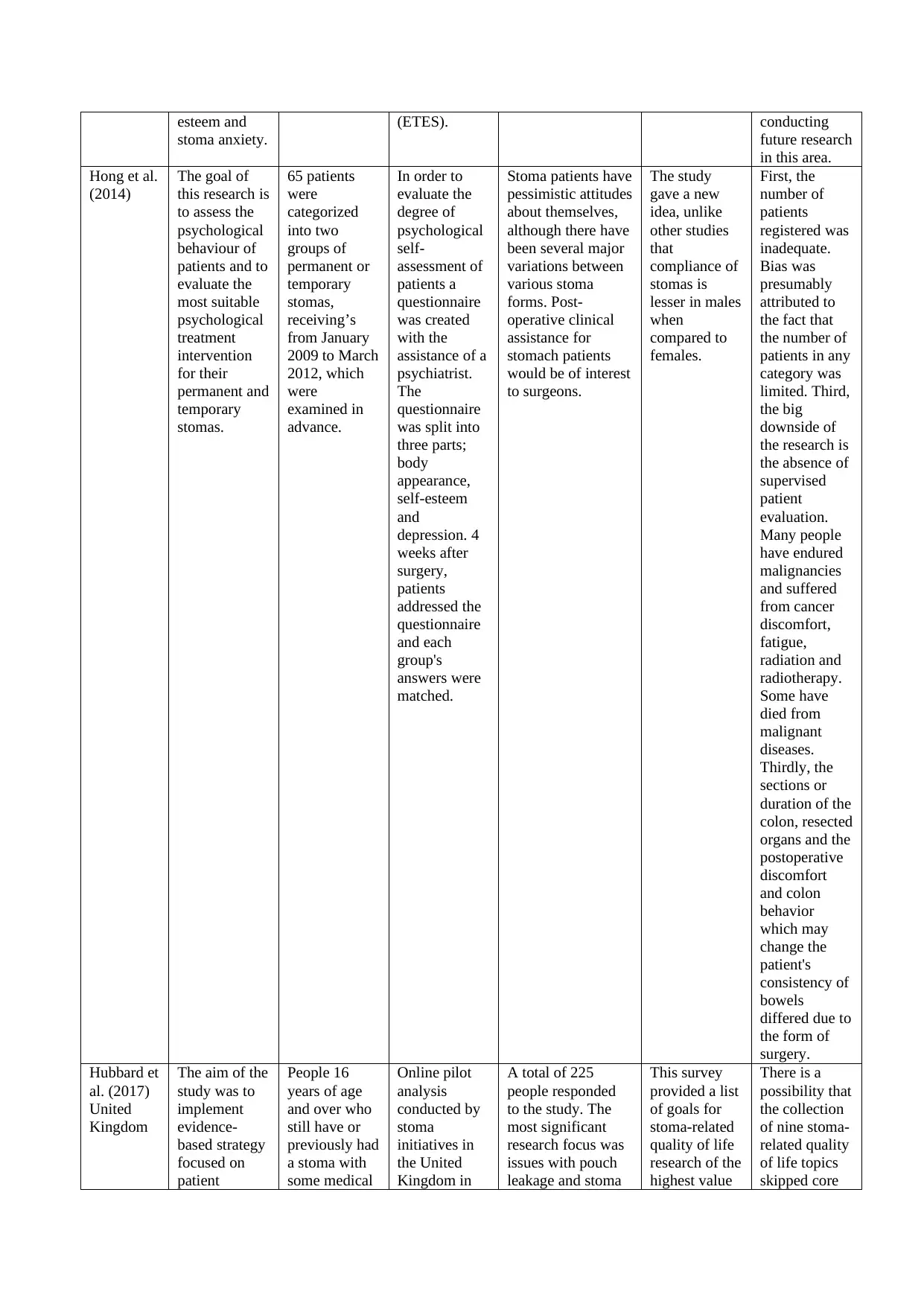
esteem and
stoma anxiety.
(ETES). conducting
future research
in this area.
Hong et al.
(2014)
The goal of
this research is
to assess the
psychological
behaviour of
patients and to
evaluate the
most suitable
psychological
treatment
intervention
for their
permanent and
temporary
stomas.
65 patients
were
categorized
into two
groups of
permanent or
temporary
stomas,
receiving’s
from January
2009 to March
2012, which
were
examined in
advance.
In order to
evaluate the
degree of
psychological
self-
assessment of
patients a
questionnaire
was created
with the
assistance of a
psychiatrist.
The
questionnaire
was split into
three parts;
body
appearance,
self-esteem
and
depression. 4
weeks after
surgery,
patients
addressed the
questionnaire
and each
group's
answers were
matched.
Stoma patients have
pessimistic attitudes
about themselves,
although there have
been several major
variations between
various stoma
forms. Post-
operative clinical
assistance for
stomach patients
would be of interest
to surgeons.
The study
gave a new
idea, unlike
other studies
that
compliance of
stomas is
lesser in males
when
compared to
females.
First, the
number of
patients
registered was
inadequate.
Bias was
presumably
attributed to
the fact that
the number of
patients in any
category was
limited. Third,
the big
downside of
the research is
the absence of
supervised
patient
evaluation.
Many people
have endured
malignancies
and suffered
from cancer
discomfort,
fatigue,
radiation and
radiotherapy.
Some have
died from
malignant
diseases.
Thirdly, the
sections or
duration of the
colon, resected
organs and the
postoperative
discomfort
and colon
behavior
which may
change the
patient's
consistency of
bowels
differed due to
the form of
surgery.
Hubbard et
al. (2017)
United
Kingdom
The aim of the
study was to
implement
evidence-
based strategy
focused on
patient
People 16
years of age
and over who
still have or
previously had
a stoma with
some medical
Online pilot
analysis
conducted by
stoma
initiatives in
the United
Kingdom in
A total of 225
people responded
to the study. The
most significant
research focus was
issues with pouch
leakage and stoma
This survey
provided a list
of goals for
stoma-related
quality of life
research of the
highest value
There is a
possibility that
the collection
of nine stoma-
related quality
of life topics
skipped core
stoma anxiety.
(ETES). conducting
future research
in this area.
Hong et al.
(2014)
The goal of
this research is
to assess the
psychological
behaviour of
patients and to
evaluate the
most suitable
psychological
treatment
intervention
for their
permanent and
temporary
stomas.
65 patients
were
categorized
into two
groups of
permanent or
temporary
stomas,
receiving’s
from January
2009 to March
2012, which
were
examined in
advance.
In order to
evaluate the
degree of
psychological
self-
assessment of
patients a
questionnaire
was created
with the
assistance of a
psychiatrist.
The
questionnaire
was split into
three parts;
body
appearance,
self-esteem
and
depression. 4
weeks after
surgery,
patients
addressed the
questionnaire
and each
group's
answers were
matched.
Stoma patients have
pessimistic attitudes
about themselves,
although there have
been several major
variations between
various stoma
forms. Post-
operative clinical
assistance for
stomach patients
would be of interest
to surgeons.
The study
gave a new
idea, unlike
other studies
that
compliance of
stomas is
lesser in males
when
compared to
females.
First, the
number of
patients
registered was
inadequate.
Bias was
presumably
attributed to
the fact that
the number of
patients in any
category was
limited. Third,
the big
downside of
the research is
the absence of
supervised
patient
evaluation.
Many people
have endured
malignancies
and suffered
from cancer
discomfort,
fatigue,
radiation and
radiotherapy.
Some have
died from
malignant
diseases.
Thirdly, the
sections or
duration of the
colon, resected
organs and the
postoperative
discomfort
and colon
behavior
which may
change the
patient's
consistency of
bowels
differed due to
the form of
surgery.
Hubbard et
al. (2017)
United
Kingdom
The aim of the
study was to
implement
evidence-
based strategy
focused on
patient
People 16
years of age
and over who
still have or
previously had
a stoma with
some medical
Online pilot
analysis
conducted by
stoma
initiatives in
the United
Kingdom in
A total of 225
people responded
to the study. The
most significant
research focus was
issues with pouch
leakage and stoma
This survey
provided a list
of goals for
stoma-related
quality of life
research of the
highest value
There is a
possibility that
the collection
of nine stoma-
related quality
of life topics
skipped core
⊘ This is a preview!⊘
Do you want full access?
Subscribe today to unlock all pages.

Trusted by 1+ million students worldwide
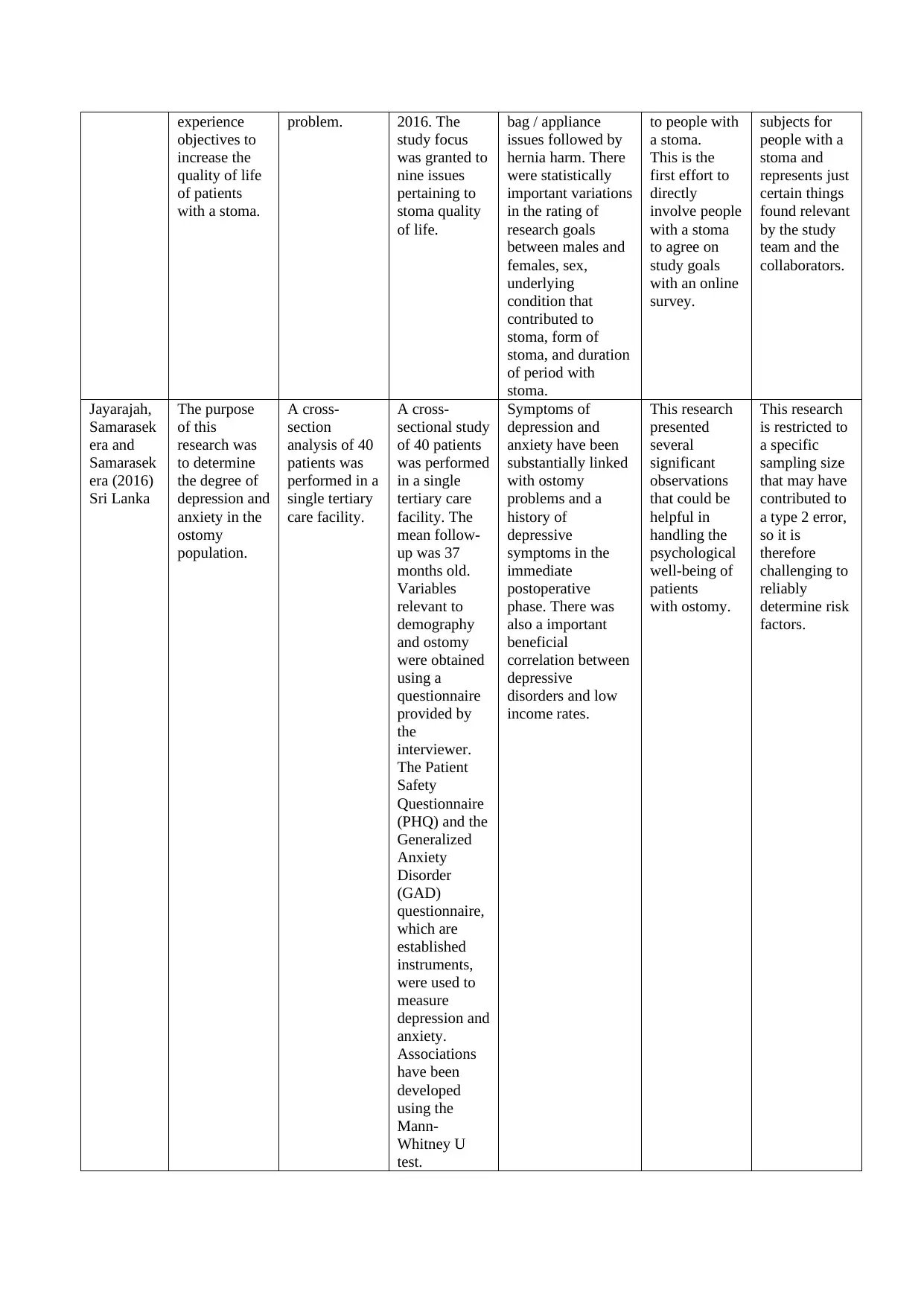
experience
objectives to
increase the
quality of life
of patients
with a stoma.
problem. 2016. The
study focus
was granted to
nine issues
pertaining to
stoma quality
of life.
bag / appliance
issues followed by
hernia harm. There
were statistically
important variations
in the rating of
research goals
between males and
females, sex,
underlying
condition that
contributed to
stoma, form of
stoma, and duration
of period with
stoma.
to people with
a stoma.
This is the
first effort to
directly
involve people
with a stoma
to agree on
study goals
with an online
survey.
subjects for
people with a
stoma and
represents just
certain things
found relevant
by the study
team and the
collaborators.
Jayarajah,
Samarasek
era and
Samarasek
era (2016)
Sri Lanka
The purpose
of this
research was
to determine
the degree of
depression and
anxiety in the
ostomy
population.
A cross-
section
analysis of 40
patients was
performed in a
single tertiary
care facility.
A cross-
sectional study
of 40 patients
was performed
in a single
tertiary care
facility. The
mean follow-
up was 37
months old.
Variables
relevant to
demography
and ostomy
were obtained
using a
questionnaire
provided by
the
interviewer.
The Patient
Safety
Questionnaire
(PHQ) and the
Generalized
Anxiety
Disorder
(GAD)
questionnaire,
which are
established
instruments,
were used to
measure
depression and
anxiety.
Associations
have been
developed
using the
Mann-
Whitney U
test.
Symptoms of
depression and
anxiety have been
substantially linked
with ostomy
problems and a
history of
depressive
symptoms in the
immediate
postoperative
phase. There was
also a important
beneficial
correlation between
depressive
disorders and low
income rates.
This research
presented
several
significant
observations
that could be
helpful in
handling the
psychological
well-being of
patients
with ostomy.
This research
is restricted to
a specific
sampling size
that may have
contributed to
a type 2 error,
so it is
therefore
challenging to
reliably
determine risk
factors.
objectives to
increase the
quality of life
of patients
with a stoma.
problem. 2016. The
study focus
was granted to
nine issues
pertaining to
stoma quality
of life.
bag / appliance
issues followed by
hernia harm. There
were statistically
important variations
in the rating of
research goals
between males and
females, sex,
underlying
condition that
contributed to
stoma, form of
stoma, and duration
of period with
stoma.
to people with
a stoma.
This is the
first effort to
directly
involve people
with a stoma
to agree on
study goals
with an online
survey.
subjects for
people with a
stoma and
represents just
certain things
found relevant
by the study
team and the
collaborators.
Jayarajah,
Samarasek
era and
Samarasek
era (2016)
Sri Lanka
The purpose
of this
research was
to determine
the degree of
depression and
anxiety in the
ostomy
population.
A cross-
section
analysis of 40
patients was
performed in a
single tertiary
care facility.
A cross-
sectional study
of 40 patients
was performed
in a single
tertiary care
facility. The
mean follow-
up was 37
months old.
Variables
relevant to
demography
and ostomy
were obtained
using a
questionnaire
provided by
the
interviewer.
The Patient
Safety
Questionnaire
(PHQ) and the
Generalized
Anxiety
Disorder
(GAD)
questionnaire,
which are
established
instruments,
were used to
measure
depression and
anxiety.
Associations
have been
developed
using the
Mann-
Whitney U
test.
Symptoms of
depression and
anxiety have been
substantially linked
with ostomy
problems and a
history of
depressive
symptoms in the
immediate
postoperative
phase. There was
also a important
beneficial
correlation between
depressive
disorders and low
income rates.
This research
presented
several
significant
observations
that could be
helpful in
handling the
psychological
well-being of
patients
with ostomy.
This research
is restricted to
a specific
sampling size
that may have
contributed to
a type 2 error,
so it is
therefore
challenging to
reliably
determine risk
factors.
Paraphrase This Document
Need a fresh take? Get an instant paraphrase of this document with our AI Paraphraser
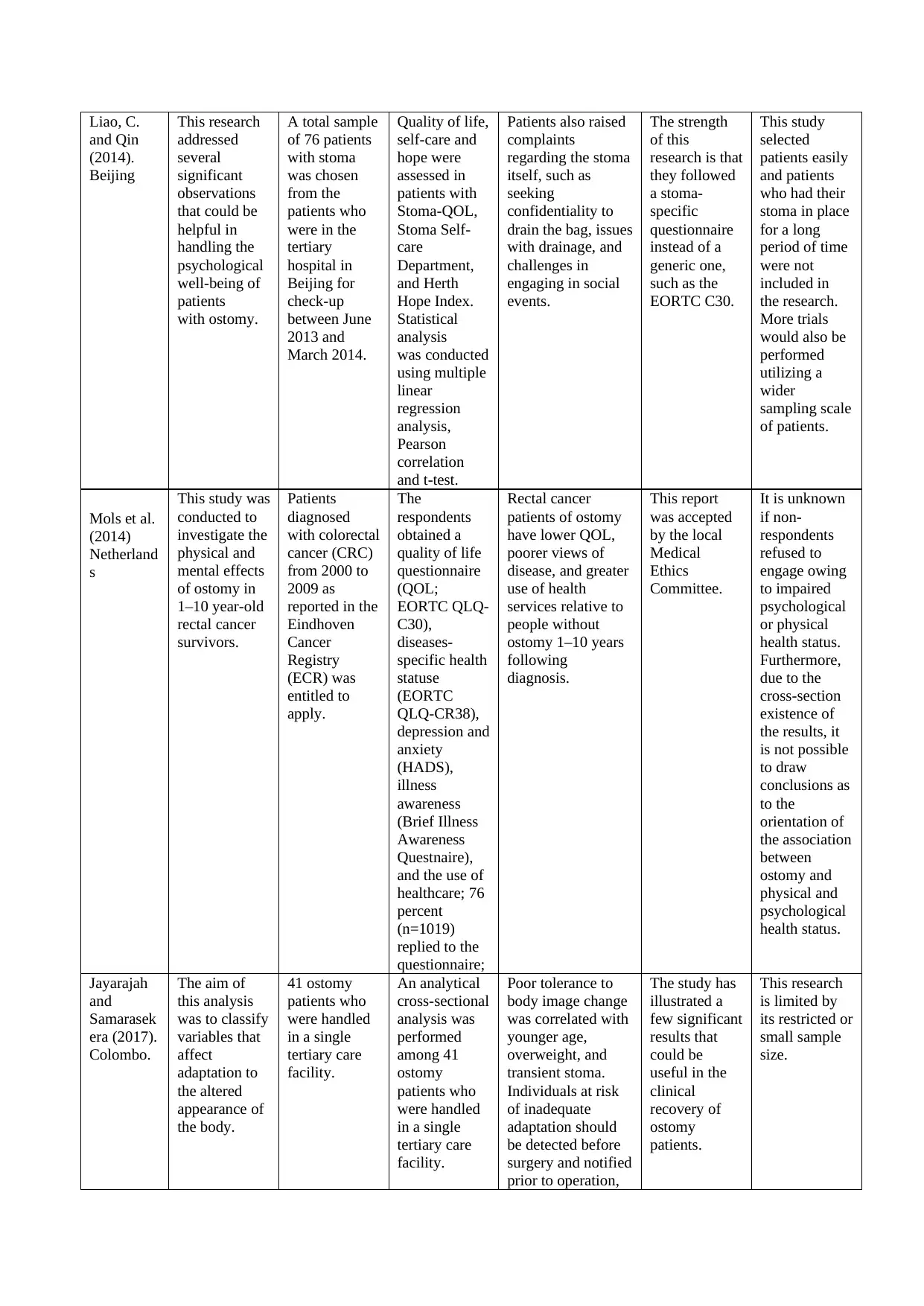
Liao, C.
and Qin
(2014).
Beijing
This research
addressed
several
significant
observations
that could be
helpful in
handling the
psychological
well-being of
patients
with ostomy.
A total sample
of 76 patients
with stoma
was chosen
from the
patients who
were in the
tertiary
hospital in
Beijing for
check-up
between June
2013 and
March 2014.
Quality of life,
self-care and
hope were
assessed in
patients with
Stoma-QOL,
Stoma Self-
care
Department,
and Herth
Hope Index.
Statistical
analysis
was conducted
using multiple
linear
regression
analysis,
Pearson
correlation
and t-test.
Patients also raised
complaints
regarding the stoma
itself, such as
seeking
confidentiality to
drain the bag, issues
with drainage, and
challenges in
engaging in social
events.
The strength
of this
research is that
they followed
a stoma-
specific
questionnaire
instead of a
generic one,
such as the
EORTC C30.
This study
selected
patients easily
and patients
who had their
stoma in place
for a long
period of time
were not
included in
the research.
More trials
would also be
performed
utilizing a
wider
sampling scale
of patients.
Mols et al.
(2014)
Netherland
s
This study was
conducted to
investigate the
physical and
mental effects
of ostomy in
1–10 year-old
rectal cancer
survivors.
Patients
diagnosed
with colorectal
cancer (CRC)
from 2000 to
2009 as
reported in the
Eindhoven
Cancer
Registry
(ECR) was
entitled to
apply.
The
respondents
obtained a
quality of life
questionnaire
(QOL;
EORTC QLQ-
C30),
diseases-
specific health
statuse
(EORTC
QLQ-CR38),
depression and
anxiety
(HADS),
illness
awareness
(Brief Illness
Awareness
Questnaire),
and the use of
healthcare; 76
percent
(n=1019)
replied to the
questionnaire;
Rectal cancer
patients of ostomy
have lower QOL,
poorer views of
disease, and greater
use of health
services relative to
people without
ostomy 1–10 years
following
diagnosis.
This report
was accepted
by the local
Medical
Ethics
Committee.
It is unknown
if non-
respondents
refused to
engage owing
to impaired
psychological
or physical
health status.
Furthermore,
due to the
cross-section
existence of
the results, it
is not possible
to draw
conclusions as
to the
orientation of
the association
between
ostomy and
physical and
psychological
health status.
Jayarajah
and
Samarasek
era (2017).
Colombo.
The aim of
this analysis
was to classify
variables that
affect
adaptation to
the altered
appearance of
the body.
41 ostomy
patients who
were handled
in a single
tertiary care
facility.
An analytical
cross-sectional
analysis was
performed
among 41
ostomy
patients who
were handled
in a single
tertiary care
facility.
Poor tolerance to
body image change
was correlated with
younger age,
overweight, and
transient stoma.
Individuals at risk
of inadequate
adaptation should
be detected before
surgery and notified
prior to operation,
The study has
illustrated a
few significant
results that
could be
useful in the
clinical
recovery of
ostomy
patients.
This research
is limited by
its restricted or
small sample
size.
and Qin
(2014).
Beijing
This research
addressed
several
significant
observations
that could be
helpful in
handling the
psychological
well-being of
patients
with ostomy.
A total sample
of 76 patients
with stoma
was chosen
from the
patients who
were in the
tertiary
hospital in
Beijing for
check-up
between June
2013 and
March 2014.
Quality of life,
self-care and
hope were
assessed in
patients with
Stoma-QOL,
Stoma Self-
care
Department,
and Herth
Hope Index.
Statistical
analysis
was conducted
using multiple
linear
regression
analysis,
Pearson
correlation
and t-test.
Patients also raised
complaints
regarding the stoma
itself, such as
seeking
confidentiality to
drain the bag, issues
with drainage, and
challenges in
engaging in social
events.
The strength
of this
research is that
they followed
a stoma-
specific
questionnaire
instead of a
generic one,
such as the
EORTC C30.
This study
selected
patients easily
and patients
who had their
stoma in place
for a long
period of time
were not
included in
the research.
More trials
would also be
performed
utilizing a
wider
sampling scale
of patients.
Mols et al.
(2014)
Netherland
s
This study was
conducted to
investigate the
physical and
mental effects
of ostomy in
1–10 year-old
rectal cancer
survivors.
Patients
diagnosed
with colorectal
cancer (CRC)
from 2000 to
2009 as
reported in the
Eindhoven
Cancer
Registry
(ECR) was
entitled to
apply.
The
respondents
obtained a
quality of life
questionnaire
(QOL;
EORTC QLQ-
C30),
diseases-
specific health
statuse
(EORTC
QLQ-CR38),
depression and
anxiety
(HADS),
illness
awareness
(Brief Illness
Awareness
Questnaire),
and the use of
healthcare; 76
percent
(n=1019)
replied to the
questionnaire;
Rectal cancer
patients of ostomy
have lower QOL,
poorer views of
disease, and greater
use of health
services relative to
people without
ostomy 1–10 years
following
diagnosis.
This report
was accepted
by the local
Medical
Ethics
Committee.
It is unknown
if non-
respondents
refused to
engage owing
to impaired
psychological
or physical
health status.
Furthermore,
due to the
cross-section
existence of
the results, it
is not possible
to draw
conclusions as
to the
orientation of
the association
between
ostomy and
physical and
psychological
health status.
Jayarajah
and
Samarasek
era (2017).
Colombo.
The aim of
this analysis
was to classify
variables that
affect
adaptation to
the altered
appearance of
the body.
41 ostomy
patients who
were handled
in a single
tertiary care
facility.
An analytical
cross-sectional
analysis was
performed
among 41
ostomy
patients who
were handled
in a single
tertiary care
facility.
Poor tolerance to
body image change
was correlated with
younger age,
overweight, and
transient stoma.
Individuals at risk
of inadequate
adaptation should
be detected before
surgery and notified
prior to operation,
The study has
illustrated a
few significant
results that
could be
useful in the
clinical
recovery of
ostomy
patients.
This research
is limited by
its restricted or
small sample
size.
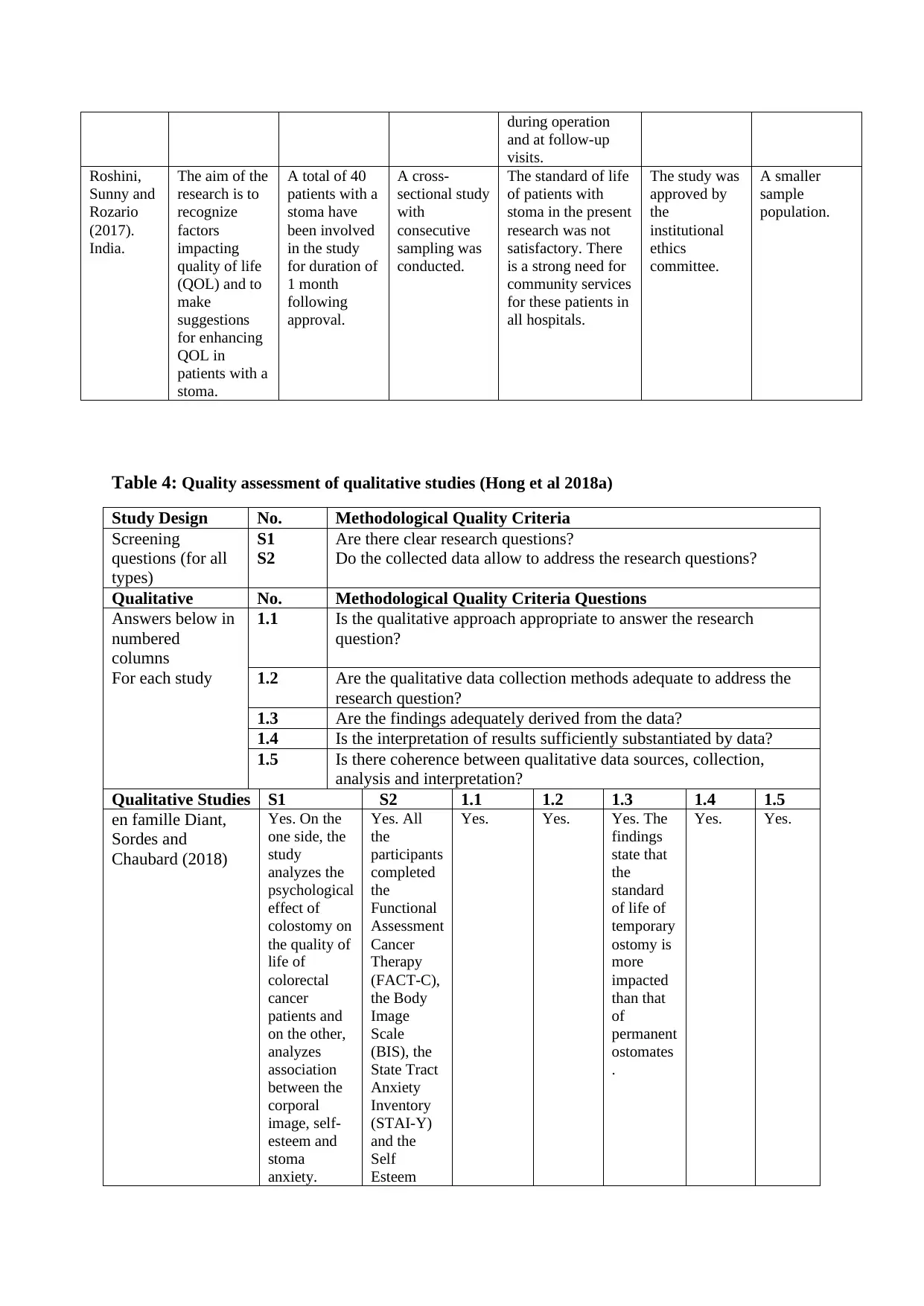
during operation
and at follow-up
visits.
Roshini,
Sunny and
Rozario
(2017).
India.
The aim of the
research is to
recognize
factors
impacting
quality of life
(QOL) and to
make
suggestions
for enhancing
QOL in
patients with a
stoma.
A total of 40
patients with a
stoma have
been involved
in the study
for duration of
1 month
following
approval.
A cross-
sectional study
with
consecutive
sampling was
conducted.
The standard of life
of patients with
stoma in the present
research was not
satisfactory. There
is a strong need for
community services
for these patients in
all hospitals.
The study was
approved by
the
institutional
ethics
committee.
A smaller
sample
population.
Table 4: Quality assessment of qualitative studies (Hong et al 2018a)
Study Design No. Methodological Quality Criteria
Screening
questions (for all
types)
S1
S2
Are there clear research questions?
Do the collected data allow to address the research questions?
Qualitative No. Methodological Quality Criteria Questions
Answers below in
numbered
columns
1.1 Is the qualitative approach appropriate to answer the research
question?
For each study 1.2 Are the qualitative data collection methods adequate to address the
research question?
1.3 Are the findings adequately derived from the data?
1.4 Is the interpretation of results sufficiently substantiated by data?
1.5 Is there coherence between qualitative data sources, collection,
analysis and interpretation?
Qualitative Studies S1 S2 1.1 1.2 1.3 1.4 1.5
en famille Diant,
Sordes and
Chaubard (2018)
Yes. On the
one side, the
study
analyzes the
psychological
effect of
colostomy on
the quality of
life of
colorectal
cancer
patients and
on the other,
analyzes
association
between the
corporal
image, self-
esteem and
stoma
anxiety.
Yes. All
the
participants
completed
the
Functional
Assessment
Cancer
Therapy
(FACT-C),
the Body
Image
Scale
(BIS), the
State Tract
Anxiety
Inventory
(STAI-Y)
and the
Self
Esteem
Yes. Yes. Yes. The
findings
state that
the
standard
of life of
temporary
ostomy is
more
impacted
than that
of
permanent
ostomates
.
Yes. Yes.
and at follow-up
visits.
Roshini,
Sunny and
Rozario
(2017).
India.
The aim of the
research is to
recognize
factors
impacting
quality of life
(QOL) and to
make
suggestions
for enhancing
QOL in
patients with a
stoma.
A total of 40
patients with a
stoma have
been involved
in the study
for duration of
1 month
following
approval.
A cross-
sectional study
with
consecutive
sampling was
conducted.
The standard of life
of patients with
stoma in the present
research was not
satisfactory. There
is a strong need for
community services
for these patients in
all hospitals.
The study was
approved by
the
institutional
ethics
committee.
A smaller
sample
population.
Table 4: Quality assessment of qualitative studies (Hong et al 2018a)
Study Design No. Methodological Quality Criteria
Screening
questions (for all
types)
S1
S2
Are there clear research questions?
Do the collected data allow to address the research questions?
Qualitative No. Methodological Quality Criteria Questions
Answers below in
numbered
columns
1.1 Is the qualitative approach appropriate to answer the research
question?
For each study 1.2 Are the qualitative data collection methods adequate to address the
research question?
1.3 Are the findings adequately derived from the data?
1.4 Is the interpretation of results sufficiently substantiated by data?
1.5 Is there coherence between qualitative data sources, collection,
analysis and interpretation?
Qualitative Studies S1 S2 1.1 1.2 1.3 1.4 1.5
en famille Diant,
Sordes and
Chaubard (2018)
Yes. On the
one side, the
study
analyzes the
psychological
effect of
colostomy on
the quality of
life of
colorectal
cancer
patients and
on the other,
analyzes
association
between the
corporal
image, self-
esteem and
stoma
anxiety.
Yes. All
the
participants
completed
the
Functional
Assessment
Cancer
Therapy
(FACT-C),
the Body
Image
Scale
(BIS), the
State Tract
Anxiety
Inventory
(STAI-Y)
and the
Self
Esteem
Yes. Yes. Yes. The
findings
state that
the
standard
of life of
temporary
ostomy is
more
impacted
than that
of
permanent
ostomates
.
Yes. Yes.
⊘ This is a preview!⊘
Do you want full access?
Subscribe today to unlock all pages.

Trusted by 1+ million students worldwide
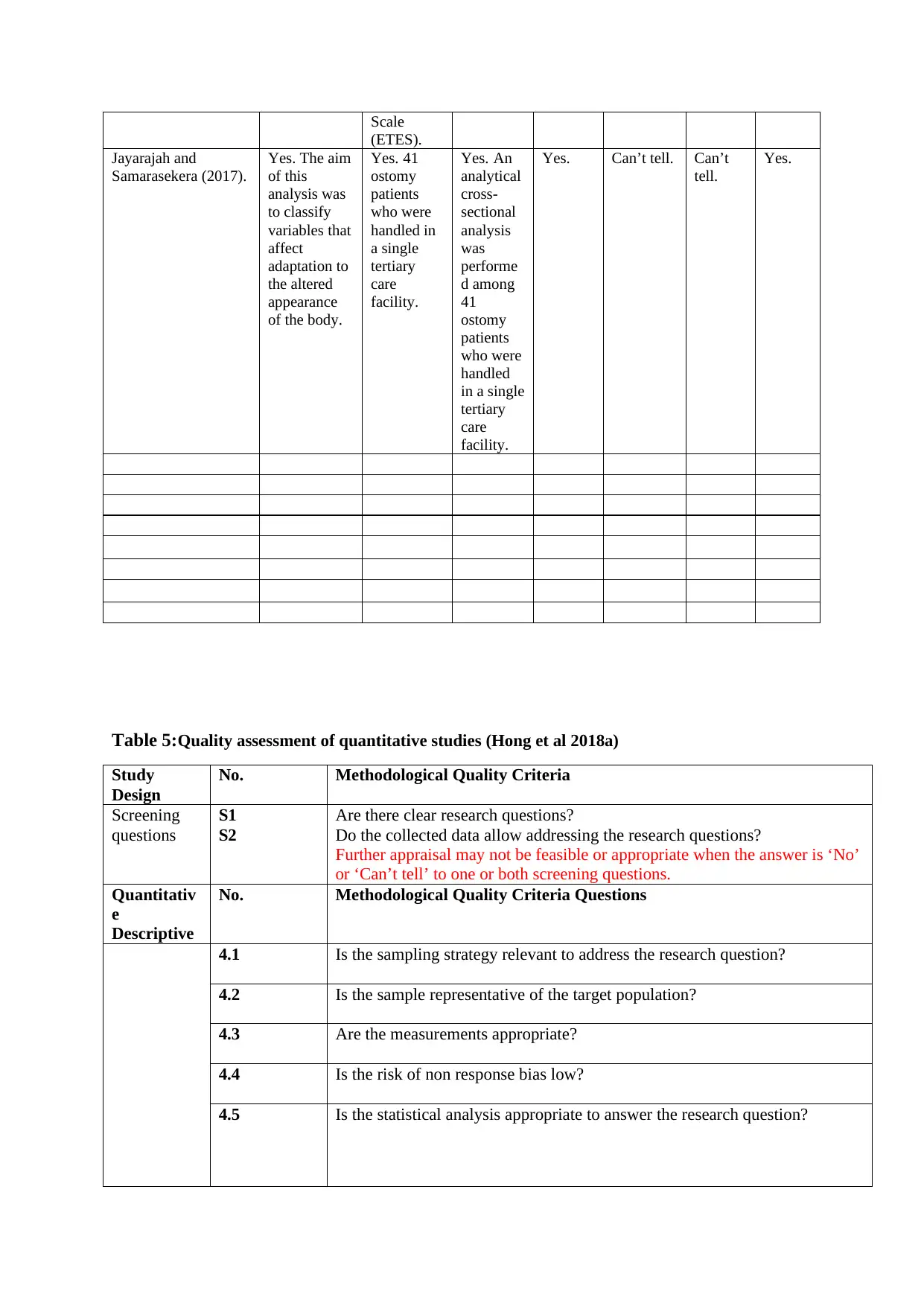
Scale
(ETES).
Jayarajah and
Samarasekera (2017).
Yes. The aim
of this
analysis was
to classify
variables that
affect
adaptation to
the altered
appearance
of the body.
Yes. 41
ostomy
patients
who were
handled in
a single
tertiary
care
facility.
Yes. An
analytical
cross-
sectional
analysis
was
performe
d among
41
ostomy
patients
who were
handled
in a single
tertiary
care
facility.
Yes. Can’t tell. Can’t
tell.
Yes.
Table 5:Quality assessment of quantitative studies (Hong et al 2018a)
Study
Design
No. Methodological Quality Criteria
Screening
questions
S1
S2
Are there clear research questions?
Do the collected data allow addressing the research questions?
Further appraisal may not be feasible or appropriate when the answer is ‘No’
or ‘Can’t tell’ to one or both screening questions.
Quantitativ
e
Descriptive
No. Methodological Quality Criteria Questions
4.1 Is the sampling strategy relevant to address the research question?
4.2 Is the sample representative of the target population?
4.3 Are the measurements appropriate?
4.4 Is the risk of non response bias low?
4.5 Is the statistical analysis appropriate to answer the research question?
(ETES).
Jayarajah and
Samarasekera (2017).
Yes. The aim
of this
analysis was
to classify
variables that
affect
adaptation to
the altered
appearance
of the body.
Yes. 41
ostomy
patients
who were
handled in
a single
tertiary
care
facility.
Yes. An
analytical
cross-
sectional
analysis
was
performe
d among
41
ostomy
patients
who were
handled
in a single
tertiary
care
facility.
Yes. Can’t tell. Can’t
tell.
Yes.
Table 5:Quality assessment of quantitative studies (Hong et al 2018a)
Study
Design
No. Methodological Quality Criteria
Screening
questions
S1
S2
Are there clear research questions?
Do the collected data allow addressing the research questions?
Further appraisal may not be feasible or appropriate when the answer is ‘No’
or ‘Can’t tell’ to one or both screening questions.
Quantitativ
e
Descriptive
No. Methodological Quality Criteria Questions
4.1 Is the sampling strategy relevant to address the research question?
4.2 Is the sample representative of the target population?
4.3 Are the measurements appropriate?
4.4 Is the risk of non response bias low?
4.5 Is the statistical analysis appropriate to answer the research question?
Paraphrase This Document
Need a fresh take? Get an instant paraphrase of this document with our AI Paraphraser
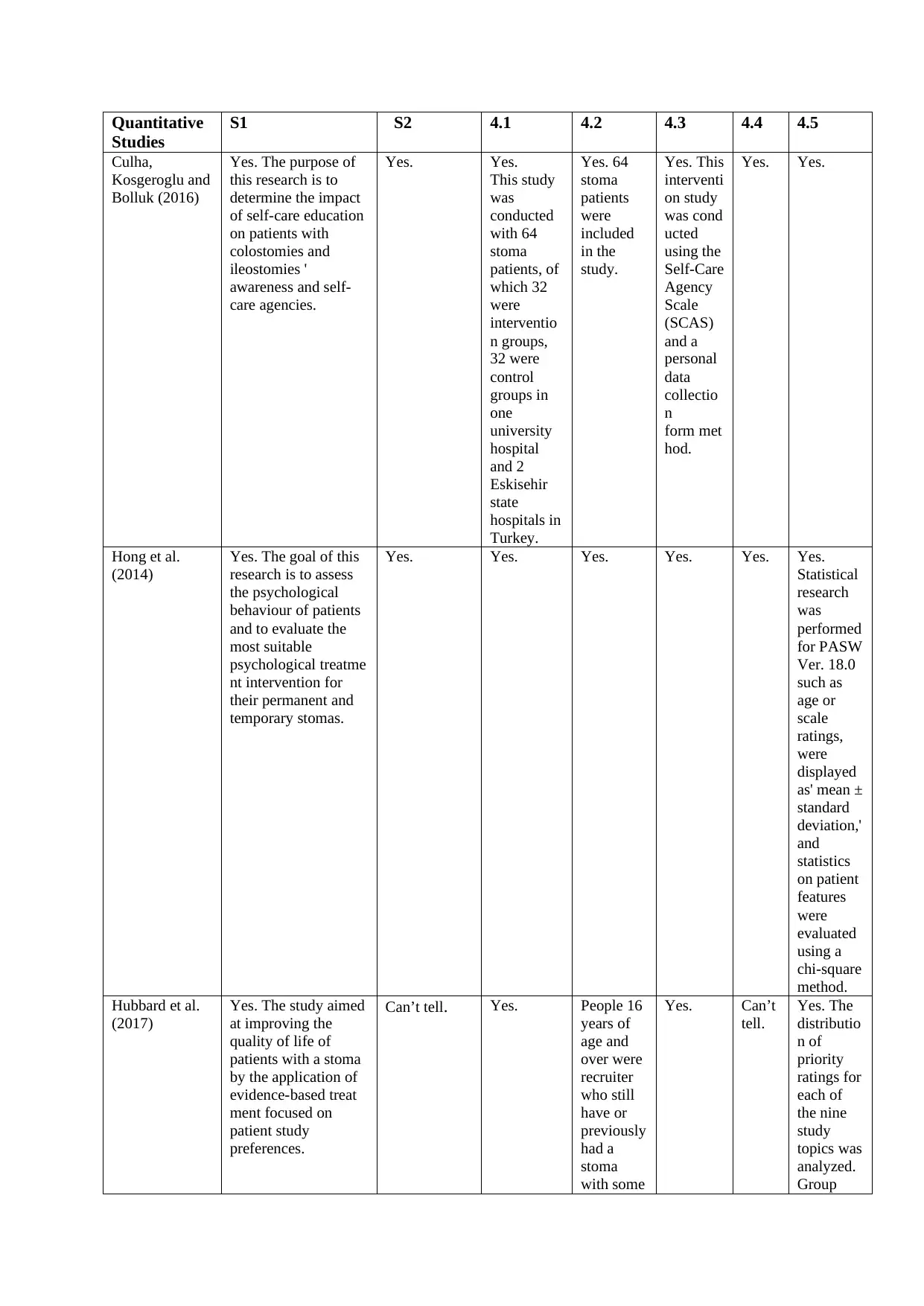
Quantitative
Studies
S1 S2 4.1 4.2 4.3 4.4 4.5
Culha,
Kosgeroglu and
Bolluk (2016)
Yes. The purpose of
this research is to
determine the impact
of self-care education
on patients with
colostomies and
ileostomies '
awareness and self-
care agencies.
Yes. Yes.
This study
was
conducted
with 64
stoma
patients, of
which 32
were
interventio
n groups,
32 were
control
groups in
one
university
hospital
and 2
Eskisehir
state
hospitals in
Turkey.
Yes. 64
stoma
patients
were
included
in the
study.
Yes. This
interventi
on study
was cond
ucted
using the
Self-Care
Agency
Scale
(SCAS)
and a
personal
data
collectio
n
form met
hod.
Yes. Yes.
Hong et al.
(2014)
Yes. The goal of this
research is to assess
the psychological
behaviour of patients
and to evaluate the
most suitable
psychological treatme
nt intervention for
their permanent and
temporary stomas.
Yes. Yes. Yes. Yes. Yes. Yes.
Statistical
research
was
performed
for PASW
Ver. 18.0
such as
age or
scale
ratings,
were
displayed
as' mean ±
standard
deviation,'
and
statistics
on patient
features
were
evaluated
using a
chi-square
method.
Hubbard et al.
(2017)
Yes. The study aimed
at improving the
quality of life of
patients with a stoma
by the application of
evidence-based treat
ment focused on
patient study
preferences.
Can’t tell. Yes. People 16
years of
age and
over were
recruiter
who still
have or
previously
had a
stoma
with some
Yes. Can’t
tell.
Yes. The
distributio
n of
priority
ratings for
each of
the nine
study
topics was
analyzed.
Group
Studies
S1 S2 4.1 4.2 4.3 4.4 4.5
Culha,
Kosgeroglu and
Bolluk (2016)
Yes. The purpose of
this research is to
determine the impact
of self-care education
on patients with
colostomies and
ileostomies '
awareness and self-
care agencies.
Yes. Yes.
This study
was
conducted
with 64
stoma
patients, of
which 32
were
interventio
n groups,
32 were
control
groups in
one
university
hospital
and 2
Eskisehir
state
hospitals in
Turkey.
Yes. 64
stoma
patients
were
included
in the
study.
Yes. This
interventi
on study
was cond
ucted
using the
Self-Care
Agency
Scale
(SCAS)
and a
personal
data
collectio
n
form met
hod.
Yes. Yes.
Hong et al.
(2014)
Yes. The goal of this
research is to assess
the psychological
behaviour of patients
and to evaluate the
most suitable
psychological treatme
nt intervention for
their permanent and
temporary stomas.
Yes. Yes. Yes. Yes. Yes. Yes.
Statistical
research
was
performed
for PASW
Ver. 18.0
such as
age or
scale
ratings,
were
displayed
as' mean ±
standard
deviation,'
and
statistics
on patient
features
were
evaluated
using a
chi-square
method.
Hubbard et al.
(2017)
Yes. The study aimed
at improving the
quality of life of
patients with a stoma
by the application of
evidence-based treat
ment focused on
patient study
preferences.
Can’t tell. Yes. People 16
years of
age and
over were
recruiter
who still
have or
previously
had a
stoma
with some
Yes. Can’t
tell.
Yes. The
distributio
n of
priority
ratings for
each of
the nine
study
topics was
analyzed.
Group
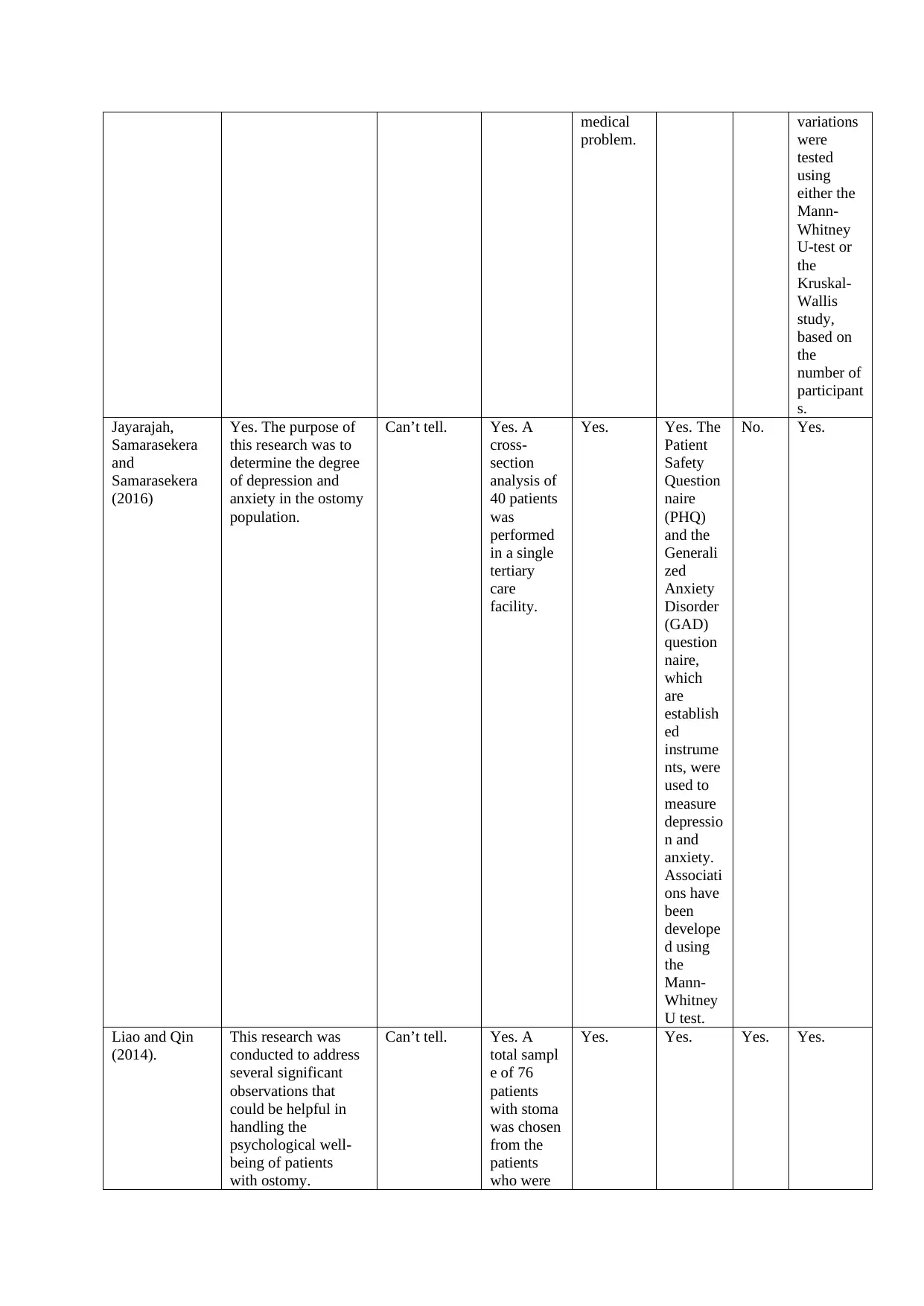
medical
problem.
variations
were
tested
using
either the
Mann-
Whitney
U-test or
the
Kruskal-
Wallis
study,
based on
the
number of
participant
s.
Jayarajah,
Samarasekera
and
Samarasekera
(2016)
Yes. The purpose of
this research was to
determine the degree
of depression and
anxiety in the ostomy
population.
Can’t tell. Yes. A
cross-
section
analysis of
40 patients
was
performed
in a single
tertiary
care
facility.
Yes. Yes. The
Patient
Safety
Question
naire
(PHQ)
and the
Generali
zed
Anxiety
Disorder
(GAD)
question
naire,
which
are
establish
ed
instrume
nts, were
used to
measure
depressio
n and
anxiety.
Associati
ons have
been
develope
d using
the
Mann-
Whitney
U test.
No. Yes.
Liao and Qin
(2014).
This research was
conducted to address
several significant
observations that
could be helpful in
handling the
psychological well-
being of patients
with ostomy.
Can’t tell. Yes. A
total sampl
e of 76
patients
with stoma
was chosen
from the
patients
who were
Yes. Yes. Yes. Yes.
problem.
variations
were
tested
using
either the
Mann-
Whitney
U-test or
the
Kruskal-
Wallis
study,
based on
the
number of
participant
s.
Jayarajah,
Samarasekera
and
Samarasekera
(2016)
Yes. The purpose of
this research was to
determine the degree
of depression and
anxiety in the ostomy
population.
Can’t tell. Yes. A
cross-
section
analysis of
40 patients
was
performed
in a single
tertiary
care
facility.
Yes. Yes. The
Patient
Safety
Question
naire
(PHQ)
and the
Generali
zed
Anxiety
Disorder
(GAD)
question
naire,
which
are
establish
ed
instrume
nts, were
used to
measure
depressio
n and
anxiety.
Associati
ons have
been
develope
d using
the
Mann-
Whitney
U test.
No. Yes.
Liao and Qin
(2014).
This research was
conducted to address
several significant
observations that
could be helpful in
handling the
psychological well-
being of patients
with ostomy.
Can’t tell. Yes. A
total sampl
e of 76
patients
with stoma
was chosen
from the
patients
who were
Yes. Yes. Yes. Yes.
⊘ This is a preview!⊘
Do you want full access?
Subscribe today to unlock all pages.

Trusted by 1+ million students worldwide
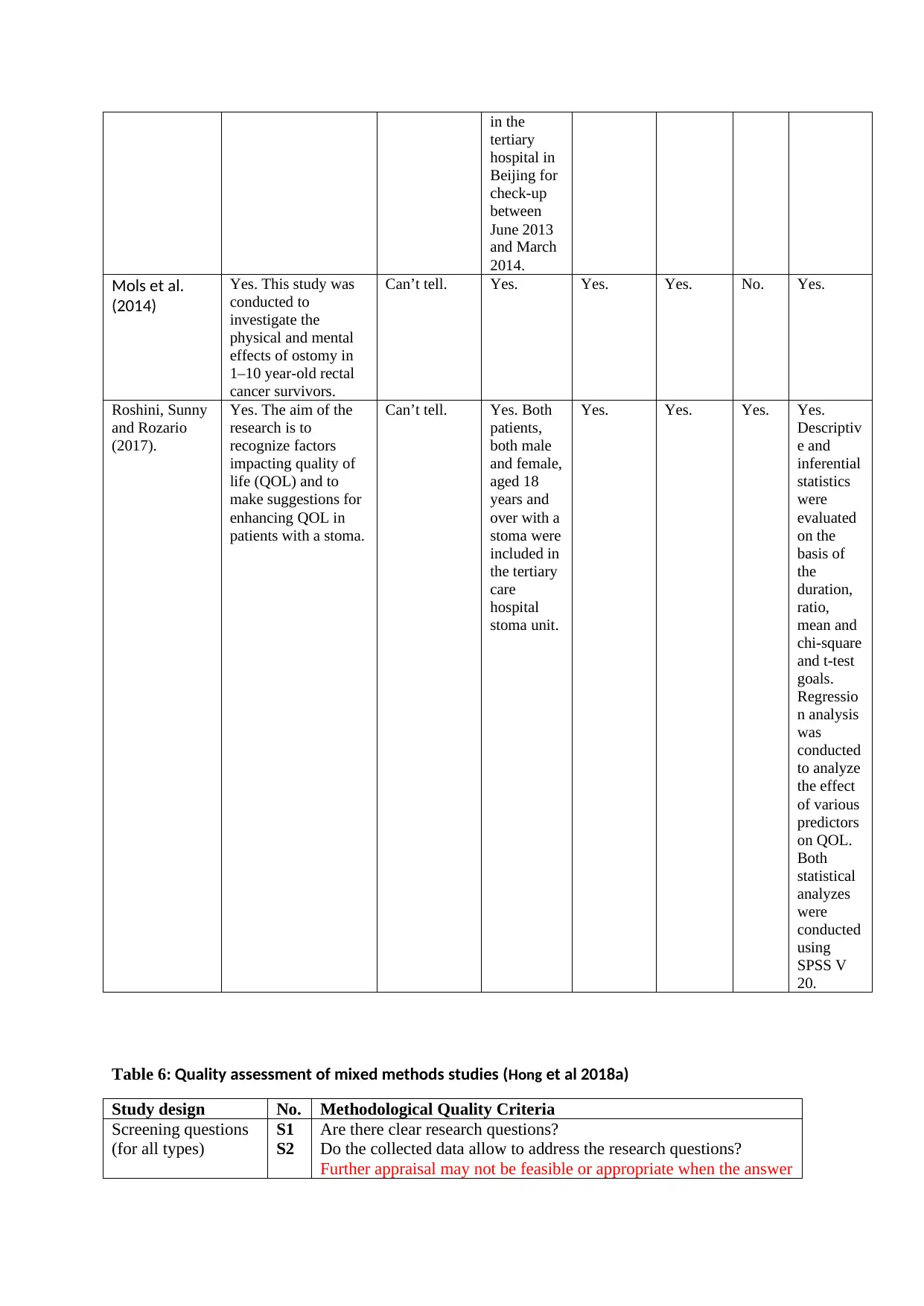
in the
tertiary
hospital in
Beijing for
check-up
between
June 2013
and March
2014.
Mols et al.
(2014)
Yes. This study was
conducted to
investigate the
physical and mental
effects of ostomy in
1–10 year-old rectal
cancer survivors.
Can’t tell. Yes. Yes. Yes. No. Yes.
Roshini, Sunny
and Rozario
(2017).
Yes. The aim of the
research is to
recognize factors
impacting quality of
life (QOL) and to
make suggestions for
enhancing QOL in
patients with a stoma.
Can’t tell. Yes. Both
patients,
both male
and female,
aged 18
years and
over with a
stoma were
included in
the tertiary
care
hospital
stoma unit.
Yes. Yes. Yes. Yes.
Descriptiv
e and
inferential
statistics
were
evaluated
on the
basis of
the
duration,
ratio,
mean and
chi-square
and t-test
goals.
Regressio
n analysis
was
conducted
to analyze
the effect
of various
predictors
on QOL.
Both
statistical
analyzes
were
conducted
using
SPSS V
20.
Table 6: Quality assessment of mixed methods studies (Hong et al 2018a)
Study design No. Methodological Quality Criteria
Screening questions
(for all types)
S1
S2
Are there clear research questions?
Do the collected data allow to address the research questions?
Further appraisal may not be feasible or appropriate when the answer
tertiary
hospital in
Beijing for
check-up
between
June 2013
and March
2014.
Mols et al.
(2014)
Yes. This study was
conducted to
investigate the
physical and mental
effects of ostomy in
1–10 year-old rectal
cancer survivors.
Can’t tell. Yes. Yes. Yes. No. Yes.
Roshini, Sunny
and Rozario
(2017).
Yes. The aim of the
research is to
recognize factors
impacting quality of
life (QOL) and to
make suggestions for
enhancing QOL in
patients with a stoma.
Can’t tell. Yes. Both
patients,
both male
and female,
aged 18
years and
over with a
stoma were
included in
the tertiary
care
hospital
stoma unit.
Yes. Yes. Yes. Yes.
Descriptiv
e and
inferential
statistics
were
evaluated
on the
basis of
the
duration,
ratio,
mean and
chi-square
and t-test
goals.
Regressio
n analysis
was
conducted
to analyze
the effect
of various
predictors
on QOL.
Both
statistical
analyzes
were
conducted
using
SPSS V
20.
Table 6: Quality assessment of mixed methods studies (Hong et al 2018a)
Study design No. Methodological Quality Criteria
Screening questions
(for all types)
S1
S2
Are there clear research questions?
Do the collected data allow to address the research questions?
Further appraisal may not be feasible or appropriate when the answer
Paraphrase This Document
Need a fresh take? Get an instant paraphrase of this document with our AI Paraphraser
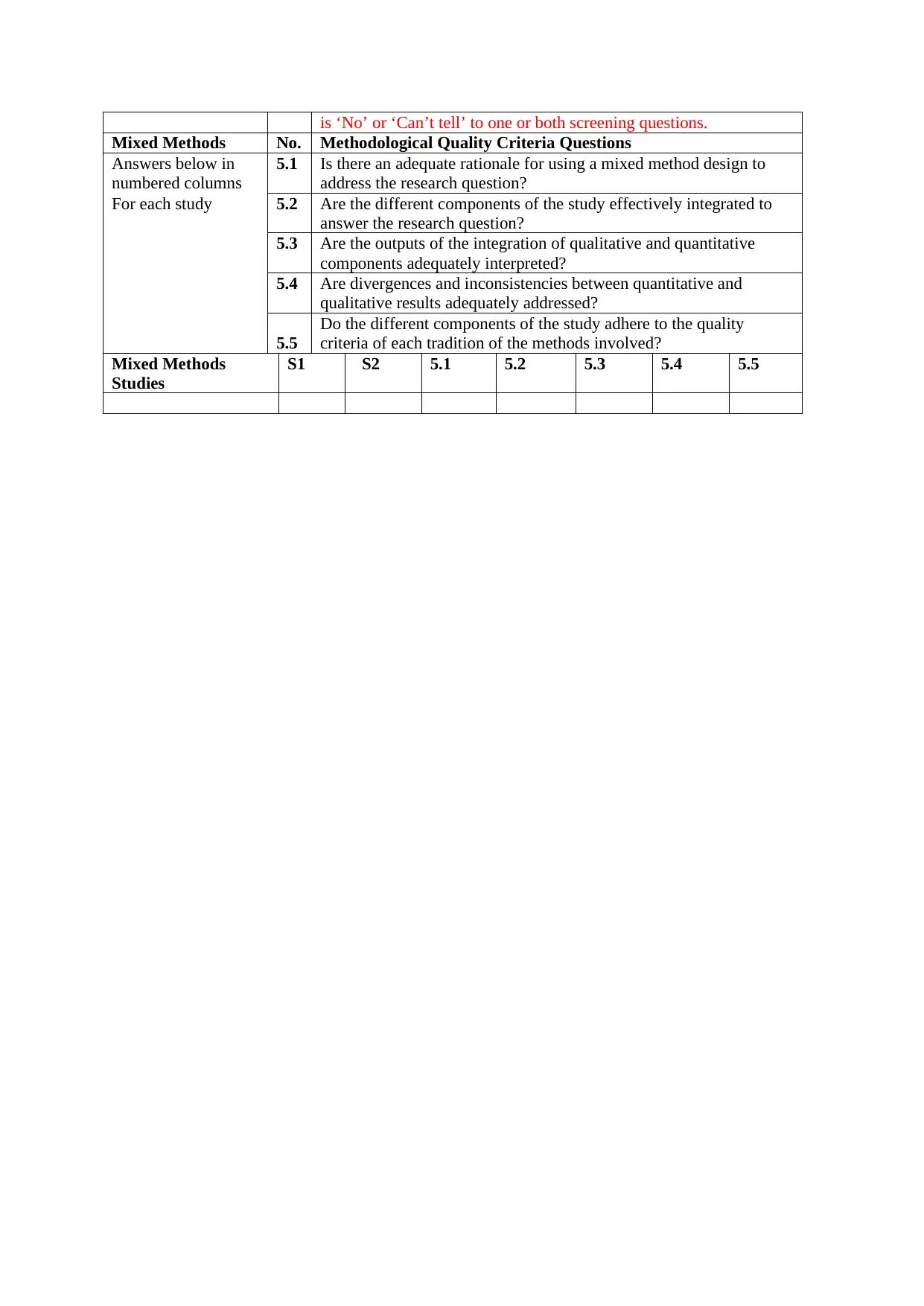
is ‘No’ or ‘Can’t tell’ to one or both screening questions.
Mixed Methods No. Methodological Quality Criteria Questions
Answers below in
numbered columns
5.1 Is there an adequate rationale for using a mixed method design to
address the research question?
For each study 5.2 Are the different components of the study effectively integrated to
answer the research question?
5.3 Are the outputs of the integration of qualitative and quantitative
components adequately interpreted?
5.4 Are divergences and inconsistencies between quantitative and
qualitative results adequately addressed?
5.5
Do the different components of the study adhere to the quality
criteria of each tradition of the methods involved?
Mixed Methods
Studies
S1 S2 5.1 5.2 5.3 5.4 5.5
Mixed Methods No. Methodological Quality Criteria Questions
Answers below in
numbered columns
5.1 Is there an adequate rationale for using a mixed method design to
address the research question?
For each study 5.2 Are the different components of the study effectively integrated to
answer the research question?
5.3 Are the outputs of the integration of qualitative and quantitative
components adequately interpreted?
5.4 Are divergences and inconsistencies between quantitative and
qualitative results adequately addressed?
5.5
Do the different components of the study adhere to the quality
criteria of each tradition of the methods involved?
Mixed Methods
Studies
S1 S2 5.1 5.2 5.3 5.4 5.5
1 out of 11
Related Documents
Your All-in-One AI-Powered Toolkit for Academic Success.
+13062052269
info@desklib.com
Available 24*7 on WhatsApp / Email
![[object Object]](/_next/static/media/star-bottom.7253800d.svg)
Unlock your academic potential
Copyright © 2020–2025 A2Z Services. All Rights Reserved. Developed and managed by ZUCOL.





